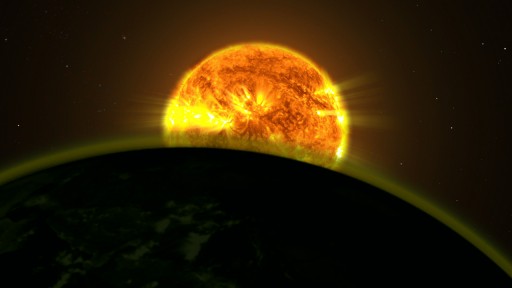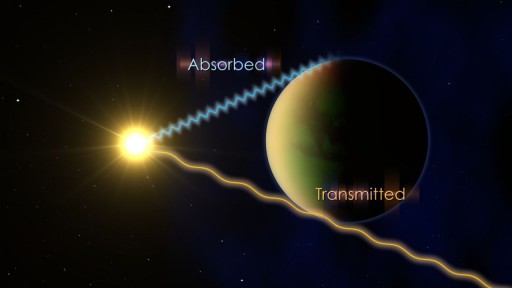Hubble traces subtle signals of water on five distant planets
December 5, 2013
[+]
Two teams of scientists have found faint signatures of water in the atmospheres of five distant planets.
NASA
scientists found faint signatures of water in the atmospheres of five
distant planets orbiting three different stars. All five planets appear
to be hazy. This illustration shows a star’s light illuminating the
atmosphere of a planet. (Credit: NASA’s Goddard Space Flight Center)
The presence of atmospheric water was reported previously on a few exoplanets orbiting stars beyond our solar system, but this is the first study to conclusively measure and compare the profiles and intensities of these signatures on multiple worlds.
Using NASA‘s Hubble Space Telescope, they observed five planets — WASP-17b, HD209458b, WASP-12b, WASP-19b and XO-1b — that orbit nearby stars. WASP-17b, a planet with an especially puffed-up atmosphere, and HD209458b had the strongest signals. The signatures for the other three planets, WASP-12b, WASP-19b and XO-1b, also are consistent with water.
“We’re very confident that we see a water signature for multiple planets,” said Avi Mandell, a planetary scientist at NASA’s Goddard Space Flight Center in Greenbelt, Md., and lead author of an Astrophysical Journal paper, published today, describing the findings for WASP-12b, WASP-17b and WASP-19b. “This work really opens the door for comparing how much water is present in atmospheres on different kinds of exoplanets, for example, hotter versus cooler ones.”
[+]
The studies were part of a census of exoplanet atmospheres led by L.
Drake Deming of the University of Maryland in College Park. Both teams
used Hubble’s Wide Field Camera 3 to explore the details of absorption
of light through the planets’ atmospheres.
To
determine what’s in the atmosphere of an exoplanet, astronomers watch
the planet pass in front of its host star and look at which wavelengths
of light are transmitted and which are partially absorbed (credit:
NASA’s Goddard Space Flight Center)
The observations were made in a range of infrared wavelengths where the water signature, if present, would appear. The teams compared the shapes and intensities of the absorption profiles, and the consistency of the signatures gave them confidence they saw water. The observations demonstrate Hubble’s continuing exemplary performance in exoplanet research.
“To actually detect the atmosphere of an exoplanet is extraordinarily difficult. But we were able to pull out a very clear signal, and it is water,” said Deming, whose team reported results for HD209458b and XO-1b in a Sept. 10 paper in the same journal. Deming’s team employed a new technique with longer exposure times, which increased the sensitivity of their measurements.
The five planets are hot Jupiters — massive worlds that orbit close to their host stars. The researchers were initially surprised that all five appeared to be hazy. But Deming and Mandell noted that other researchers are finding evidence of haze around exoplanets.
“These studies, combined with other Hubble observations, are showing us that there are a surprisingly large number of systems for which the signal of water is either attenuated or completely absent,” said Heather Knutson of the California Institute of Technology, a co-author on Deming’s paper. “This suggests that cloudy or hazy atmospheres may in fact be rather common for hot Jupiters.”
Hubble’s high-performance Wide Field Camera 3 is one of few capable of peering into the atmospheres of exoplanets many trillions of miles away. These exceptionally challenging studies can be done only if the planets are spotted while they are passing in front of their stars. Researchers can identify the gases in a planet’s atmosphere by determining which wavelengths of the star’s light are transmitted and which are partially absorbed.
Abstract of The Astrophysical Journal paper
We report an analysis of transit spectroscopy of the extrasolar planets WASP-12 b, WASP-17 b, and WASP-19 b using the Wide Field Camera 3 (WFC3) on the Hubble Space Telescope (HST). We analyze the data for a single transit for each planet using a strategy similar, in certain aspects, to the techniques used by Berta et al., but we extend their methodology to allow us to correct for channel- or wavelength-dependent instrumental effects by utilizing the band-integrated time series and measurements of the drift of the spectrum on the detector over time. We achieve almost photon-limited results for individual spectral bins, but the uncertainties in the transit depth for the band-integrated data are exacerbated by the uneven sampling of the light curve imposed by the orbital phasing of HST‘s observations. Our final transit spectra for all three objects are consistent with the presence of a broad absorption feature at 1.4 μm most likely due to water. However, the amplitude of the absorption is less than that expected based on previous observations with Spitzer, possibly due to hazes absorbing in the NIR or non-solar compositions. The degeneracy of models with different compositions and temperature structures combined with the low amplitude of any features in the data preclude our ability to place unambiguous constraints on the atmospheric composition without additional observations with WFC3 to improve the signal-to-noise ratio and/or a comprehensive multi-wavelength analysis.
(¯`*• Global Source and/or more resources at http://goo.gl/zvSV7 │ www.Future-Observatory.blogspot.com and on LinkeIn Group's "Becoming Aware of the Futures" at http://goo.gl/8qKBbK │ @SciCzar │ Point of Contact: www.linkedin.com/in/AndresAgostini
 Washington
Washington